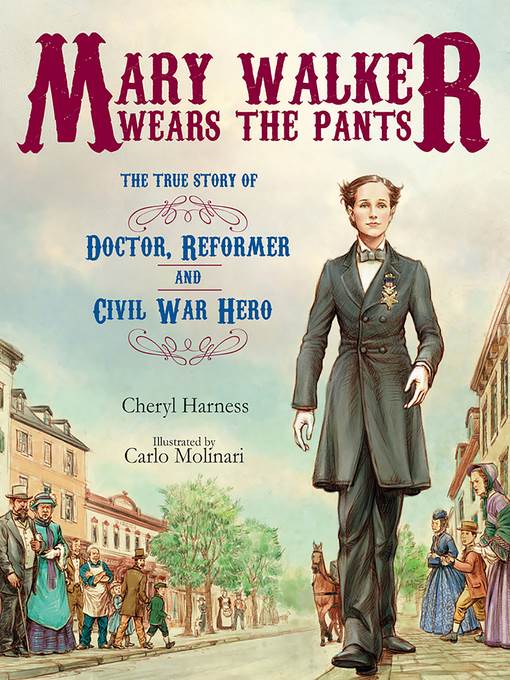
Mary Walker Wears the Pants
The True Story of the Doctor, Reformer, and Civil War Hero
فرمت کتاب
ebook
تاریخ انتشار
2013
Lexile Score
910
Reading Level
4-5
ATOS
5.5
Interest Level
K-3(LG)
نویسنده
Carlo Molinariشابک
9780807549919
کتاب های مرتبط
- اطلاعات
- نقد و بررسی
- دیدگاه کاربران
نقد و بررسی

April 15, 2013
Back when wearing pants was an act of defiance for women, Mary Walker sported them with poise. As a Civil War surgeon and activist, pants allowed her freedom of movement. Molinari shows a coiffed Walker striding confidently in a man’s tailored suit, as women glower in bonnets and floor-length dresses. In detailed prose, Harness describes Walker caring for the war wounded, being captured as a suspected spy (“It is likely that this was true”), and eventually receiving a Medal of Honor. Throughout, Harness underscores the greater implications of Walker’s attire: “There was more to Mary than her trousers. She lived as she believed, as an individual, fully equal and entitled to walk, breathe, and think freely, unbound by a corset or her society’s expectations.” An endnote further explores Walker’s life. Ages 6–9.

April 1, 2013
Gr 2-5-'"Scandalous!' 'Positively sinful!' 'Outrageous!'" That is what people had to say about women's rights advocate, doctor, and abolitionist Mary Walker in the mid-19th century. Raised to be an independent thinker, she wore pants both literally and figuratively. Societal attitudes and expectations meant little to one of the first women doctors and the first woman to receive the Medal of Honor for her "services and sufferings" during wartime. Though she initially served as a volunteer for the Union Army during the Civil War, her hard work and determination finally led to her appointment as an assistant surgeon in 1863, the first woman doctor in the U.S. Army. The child-friendly text, peppered with colorful quotes and descriptions, works both as a read-aloud and a read alone to bring this little-known heroine to life. Molinari's realistic watercolor illustrations are full of period details. The scandalized town gossips appear rightfully judgmental and ridiculous. Iconic images of weary soldiers, hospital wards, the Union and Confederate flags, and Abraham Lincoln tipping his hat to some passersby all capture the era. Pair this with Shana Corey's You Forgot Your Skirt, Amelia Bloomer! (Scholastic, 2000), about another suffragette. A solid addition for women's history or Civil War units.-Barbara Auerbach, New York City Public Schools
Copyright 2013 School Library Journal, LLC Used with permission.

March 1, 2013
Pants: Women were not supposed to wear them. Mary Walker not only got her medical degree in 1855, but found it much easier to do her work dressed smartly in men's trousers and tailored jacket. She was not accepted in the Union Army at first, but as an unpaid hospital volunteer, she tended the Civil War sick and wounded in Washington, D.C., and field hospitals. She was finally commissioned in late 1863, then captured and imprisoned by the Confederates. She was exchanged for a Confederate officer, and in 1866, she was given the Medal of Honor, the first and only woman to receive it. Harness tries valiantly to work this complicated story into one comprehensible for the early grades, but it makes for some difficult phrasing. Calling her, as some did, a "pesky camp follower" has very negative implications that adults, at least, will get. "Many Americans, especially in the South, firmly believed that enslaving people from Africa was a normal thing to do," is an awkward encapsulation of the reason for the Civil War. Molinari's images are richly colored and drawn in an old-fashioned but very compatible style and do a lot toward fleshing out the text. Despite awkwardness, this is a welcome window into an important American life. (Picture book/biography. 7-9)
COPYRIGHT(2013) Kirkus Reviews, ALL RIGHTS RESERVED.

June 1, 2013
Grades 2-4 Most children won't recognize the name Mary Walker, but they should. One of the first female doctors in the U.S., she served the North during the bloody Civil War. At first Walker was told to be a nurse like Florence Nightingale, but finally she practiced medicine on battlefields from Virginia to Tennessee, before being taken prisoner by the South. In 1865, she received a Medal of Honor for her war work. Her accomplishments weren't the only thing that set her apart: Walker was a devotee of pant suits, which perhaps caused more consternation than her profession. There are a few instances in the text where points could be better explained for kids (why should the wounded be carried with heads higher than their feet?), and both the writing and the art can be stiff at times. But readers will be impressed by the story of Mary's bravery and her constancy in thinking for herself despite mockery and ridicule. The author's note adds context and information, and the illustration of an elderly pant-suited Mary speaking to a crowd is a fitting conclusion.(Reprinted with permission of Booklist, copyright 2013, American Library Association.)

























دیدگاه کاربران